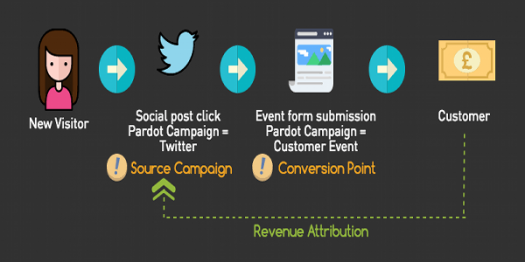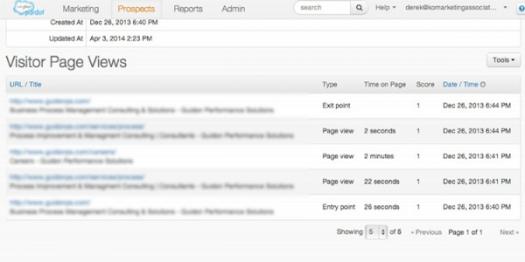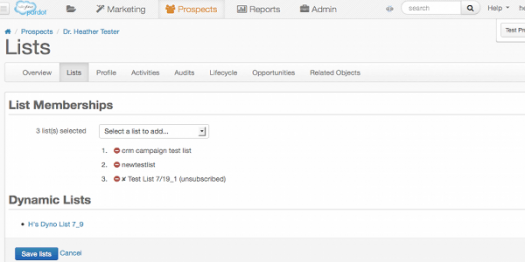Pardot Consultant Quiz
Pardot is really good if you wanna grow your business through marketing automated system. If you're thinking of pursuing your carrer as a Pardot consultant then this quiz might be beneficial for you to increase the knowledge. Take this quiz!
- 1.
How does Pardot track visitors?
- A.
Through internet
- B.
Embedded site
- C.
Through depression
- D.
All of the above
Correct Answer
B. Embedded siteExplanation
Pardot tracks visitors through an embedded site. This means that Pardot uses a tracking code that is embedded within a website to collect data on visitor behavior and interactions. By embedding the tracking code, Pardot can monitor visitor activities such as page views, form submissions, and email clicks, providing valuable insights and analytics to businesses.Rate this question:
-
- 2.
How do they get visitor's location?
- A.
Ip address
- B.
Through mable
- C.
Diagnosis
- D.
All of the above
Correct Answer
A. Ip addressExplanation
The correct answer is "Ip address". The IP address is a unique numerical label assigned to each device connected to a computer network that uses the Internet Protocol for communication. Websites can use the visitor's IP address to determine their approximate location. This information can be used for various purposes, such as displaying location-specific content or targeting advertisements.Rate this question:
-
- 3.
Who is a visitor?
- A.
A person
- B.
An unidentified entity
- C.
A brogan
- D.
An impractical person
Correct Answer
B. An unidentified entityExplanation
A visitor is someone who is not known or recognized, hence they can be considered as an unidentified entity. They are someone who is not familiar to the place or the people they are visiting, and their presence may be temporary or for a specific purpose. Therefore, the answer "An unidentified entity" accurately describes the concept of a visitor.Rate this question:
-
- 4.
You can get visitor's IP address.
- A.
True
- B.
False
- C.
Maybe
- D.
Other
Correct Answer
A. TrueExplanation
The correct answer is true because it is possible to obtain a visitor's IP address. An IP address is a unique identifier assigned to each device connected to a network. By capturing the IP address of a visitor, it is possible to gather information about their location, internet service provider, and other details. This can be useful for various purposes such as website analytics, security measures, and personalization of content.Rate this question:
-
- 5.
A visitor cannot become a prospect.
- A.
True
- B.
False
- C.
Maybe
- D.
Sometimes
Correct Answer
B. FalseExplanation
The statement "A visitor cannot become a prospect" is false. A visitor refers to someone who visits a website or a physical location, while a prospect is a potential customer who has shown interest in a product or service. It is possible for a visitor to become a prospect if they express interest or provide their contact information, indicating a potential sales opportunity. Therefore, the correct answer is false.Rate this question:
-
- 6.
How can vistors become prospects?
- A.
By getting their address
- B.
By getting their information
- C.
By helping other
- D.
Others
Correct Answer
B. By getting their informationExplanation
Visitors can become prospects by getting their information. This implies that in order to convert visitors into potential customers, it is essential to gather their contact details or any other relevant information. This information can be used to follow up with the visitors, provide them with more targeted and personalized content, and ultimately nurture them into becoming potential leads or customers. By obtaining their information, businesses can establish a direct line of communication with the visitors and further engage them in their products or services.Rate this question:
-
- 7.
Lists are part of Pardot Consultancy?
- A.
True
- B.
False
- C.
Maybe
- D.
Inconclusive
Correct Answer
A. TrueExplanation
The question is asking whether lists are part of Pardot Consultancy. The correct answer is True because lists are indeed a part of Pardot Consultancy. In Pardot, lists are used to organize and segment contacts, allowing users to target specific groups of contacts for marketing campaigns and automation. Therefore, the statement "Lists are part of Pardot Consultancy" is accurate.Rate this question:
-
- 8.
What are Lists?
- A.
Group of prospects
- B.
Group of emails
- C.
Pratical people
- D.
Other
Correct Answer
A. Group of prospectsExplanation
Lists refer to a group of prospects in the context of this question. It is a term commonly used in marketing and sales to categorize and organize potential customers or clients. By creating lists, businesses can segment their target audience based on various criteria such as demographics, interests, or purchasing behavior. This allows for more targeted and personalized communication and marketing efforts, ultimately increasing the chances of converting prospects into customers.Rate this question:
-
- 9.
Which of these is not a type list?
- A.
Suppression
- B.
Dynamic
- C.
Static
- D.
None of the above
Correct Answer
D. None of the aboveExplanation
The given options are "Suppression," "Dynamic," "Static," and "None of the above." The question asks for the type of list that is not included in these options. Since "None of the above" is listed as an option, it means that all the other options ("Suppression," "Dynamic," and "Static") are types of lists. Therefore, the correct answer is "None of the above" because it is not a type of list.Rate this question:
-
- 10.
Custom roles is not an element of Pardot Consultancy.
- A.
True
- B.
False
- C.
Sometimes
- D.
Hardly
Correct Answer
B. FalseExplanation
The statement "Custom roles is not an element of Pardot Consultancy" is incorrect. Custom roles are indeed an element of Pardot Consultancy. Pardot allows users to create custom roles with specific permissions and access levels, enabling organizations to tailor the system to their specific needs and ensure appropriate user access and security.Rate this question:
-
Quiz Review Timeline +
Our quizzes are rigorously reviewed, monitored and continuously updated by our expert board to maintain accuracy, relevance, and timeliness.
-
Current Version
-
Jan 31, 2023Quiz Edited by
ProProfs Editorial Team -
Jan 13, 2019Quiz Created by
Lynn Bradley
- Accounting Quizzes
- Advertising Quizzes
- Agriculture Quizzes
- Automotive Quizzes
- Brand Quizzes
- Business Accounting Quizzes
- Business Analyst Quizzes
- Business Development Quizzes
- Business Environment Quizzes
- Business Etiquette Quizzes
- Business Finance Quizzes
- Business Math Quizzes
- Business Organization Quizzes
- Business Plan Quizzes
- Business Process Quizzes
- Business Study Quizzes
- Business Technology Quizzes
- CEO Quizzes
- Collaboration Quizzes
- Company Quizzes
- Construction Quizzes
- Consumer Quizzes
- CSR Quizzes
- Customer Quizzes
- Customer Service Quizzes
- Development Quizzes
- Ecommerce Quizzes
- Employment Quizzes
- Entrepreneurship Quizzes
- Finance Quizzes
- Hospitality Quizzes
- Human Resources Quizzes
- Industry Quizzes
- International Business Quizzes
- Introduction To Business Quizzes
- Investment Quizzes
- Logistics Quizzes
- Management Quizzes
- Manufacturing Quizzes
- Marketing Quizzes
- Material Quizzes
- Media Quizzes
- Office Quizzes
- Organization Quizzes
- Principles Of Business Quizzes
- Printing Quizzes
- Product Quizzes
- Publishing Quizzes
- Real Estate Quizzes
- Retail Quizzes
- Sales Quizzes
- SAP Business One Quizzes
- Small Business Quizzes
- Source Quizzes
- Supply Quizzes
- Survey Quizzes
- Telecommunication Quizzes
- Trade Quizzes
- Training Quizzes
- Transportation Quizzes
- Warehouse Quizzes
- Welding Quizzes














 Back to top
Back to top